|
 Lachnum hyalopus Lachnum hyalopus
SynonymsErinella hyalopus
Dasyscyphus hyalopus
BiostatusPresent in region - Indigenous. Endemic
Images (click to enlarge)
Caption: Fig. 6. Dasyscyphus hyalopus. Apothecium x 30, ascus, paraphysis, spores and hairs x 660. | 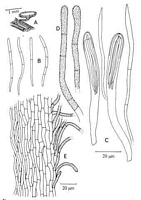
Caption: Figure 92. Lachnum hyalopus, holotype. A. Apothecium. B. Ascospores. C. Asci and
paraphyses. D. Hairs. E. Ectal excipulum on stipe. | 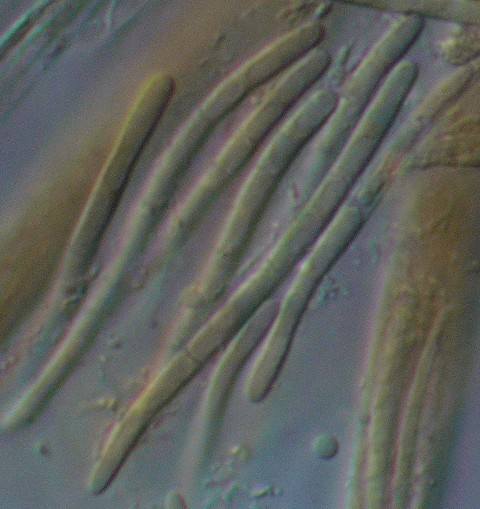
Caption: Ascospores
Owner: P.R. Johnston | 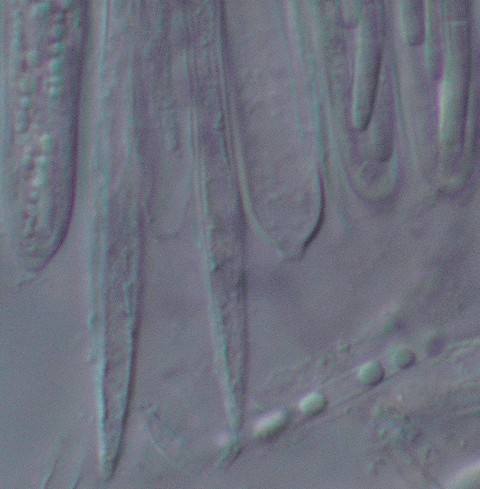
Caption: Apex of paraphyses.
Owner: P.R. Johnston | 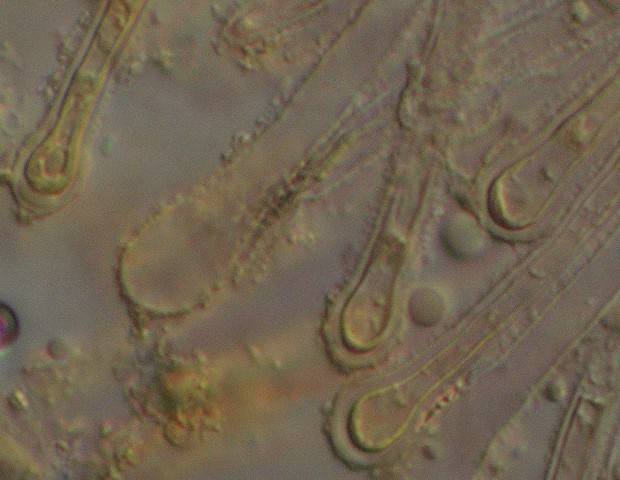
Caption: Hairs with swollen apex
Owner: P.R. Johnston | 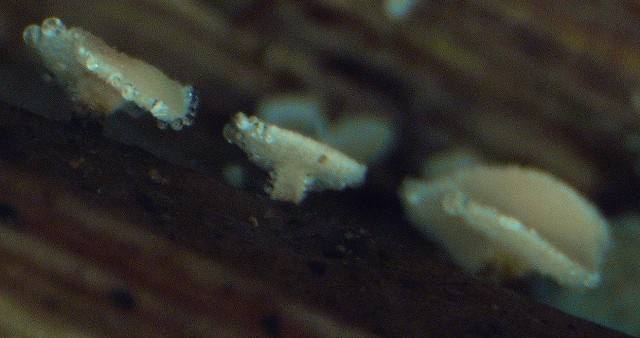
Caption: Apothecia about 1 mm diam., with short stipe
Owner: P.R. Johnston | 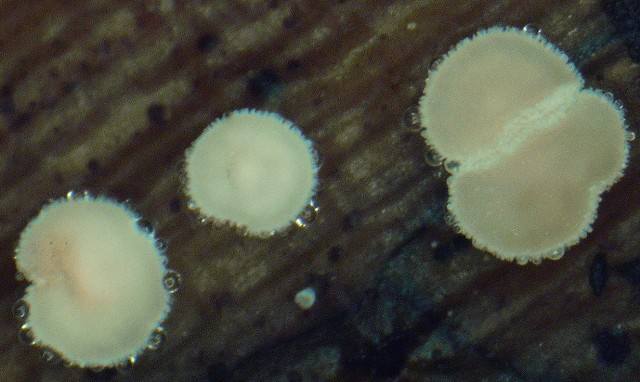
Caption: Apothecia about 1 mm diam.
Owner: P.R. Johnston |
Article: Spooner, B.M. (1987). Helotiales of Australasia: Geoglossaceae, Orbiliaceae, Sclerotiniaceae, Hyaloscyphaceae. Bibliotheca Mycologica 116: 711 p.
Description: APOTHECIA gregarious to scattered, superficial, stipitate. DISC 0.4-1.0 mm diam., plano-concave, very pale orange, drying pale amber or buff. RECEPTACLE shallow cupulate to
patellate, somewhat translucent, white, clothed with white hairs. STIPE central slender, up to
1 mm high, cylindric, concolorous or darker at the base, similarly clothed with hairs. HAIRS
hyaline, cylindric, flexuous, 3.5-4.5 µm diam., 40-80(-100) µm long, frequently swollen at the
tips of 5-6 µm diam., thin-walled, septate, finely granulate throughout, lacking crystals or
resinous exudate. ASCI 85-95 x 7.5-8.5 µm, 8-spored, cylindric-clavate, narrowed at the
base, apex conical, the pore blue in Melzer's reagent. ASCOSPORES 35-47 x 1.5-2.0, mean
41.5 (SD 3.3) x mean 1.7 (SD 0.1) µm, hyaline, narrowly cylindric, rounded at the ends, often
slightly tapered to the distal end, curved or flexuous, becoming 1-3(-5)-septate, lying parallel
in a single fascicle within the ascus. PARAPHYSES lanceolate, 3-4 µm diam., septate,
exceeding the asci by up to 20 µm. SUBHYMENIUM not clearly differentiated.
MEDULLARY EXCIPULUM composed of hyaline, thin-walled, septate, interwoven hyphae
2.0-3.5 µm diam. Stipe medulla a textura porrecta formed of thin-walled, septate hyphae 2-3
µm diam., and continuing into the receptacle as a narrow layer adjacent to the ectal excipulum.
ECTAL EXCIPULUM 30-35 µm thick on the stipe and lower receptacle, narrowed towards
the margin, hyaline, composed of regular rows of thin-walled, narrow, prismatic cells 15-25 x
3-5 µm arranged at a very low angle to the surface
Habitat: Saprophytic, on leaves of Phormium sp. (Agavaceae).
New Zealand, known only from the type collection.
Notes: It seems probable that this species is closely related to Lachnum apalum, which has similar,
stipitate apothecia and comparable spores but differs in its longer, more broadly lanceolate
paraphyses, and is evidently restricted to culms of Juncus species. It also lacks the swollen
tips to the hairs which commonly occur in L. hyalopus. Dasyscyphus apalus var. polylepidis
Dennis, on leaves of Polylepis serica in Venezuela, is closely similar but has shorter spores
only 25-30 µm long, and is probably a good species. Lachnum hyalopus appears to be
distinct, and it is to be hoped that further collections will become available to allow more
detailed comparison with related taxa.
Article: Cooke, M.C. (1890). Fungi of New Zealand. Grevillea 19(90): 47-49.
Article: Dennis, R.W.G. (1958). Critical notes on some Australian Helotiales and Ostropales. Kew Bulletin 13(2): 321-358.
Description: Apothecia scattered, superficial ; disc concave, about 0.5 mm. diameter; receptacle cup-shaped, soft and delicate, white, clothed with short white hairs; stipe slender, cylindrical,
hairy, white or drying buff towards the base. Hairs cylindrical, 80-100 x 3-4 µ, tips slightly
swollen to 4-6 µ and rounded, walls thin, hyaline, granulate, septa usually 3. Asci cylindric-clavate, 95 - 100 x 9-10 µ, 8-spored, pore blued by Melzer's reagent; ascospores parallel,
narrowly cylindrical, curved or undulating, ends obtuse, ultimately multi-septate, 39-46 x 2 µ.
Paraphyses lanceolate, 3 µ wide.
Notes: This species closely resembles D. dussii Dennis, on twigs in Guadeloupe, but in the latter the
whole fungus is light yellow and the terminal cell of each hair is filled with yellow oil. Fresh
collections or good field notes on fresh apothecia are desirable for comparison with the
common D. apalus (Berk. & Br.) Dennis which, however, typically lacks the swollen tips to
the hairs and is commonly supposed to be confined to Juncus.
|